Government Grants
Business Grants
Home Owner Programs
Federal Programs
About Us
Child and Youth Education Response Activity (CYERA)
The Democratic Republic of the Congo (DRC) is the fifth most fragile state in the world, with a humanitarian context characterized by recurrent patterns of conflict and displacement, exacerbated by epidemic outbreaks and natural disasters.
Prolonged conflict in certain parts of the DRC is
complex, with ethnic, international, and financial interests at play at all geographic administrative levels.
These interests, compounded by poor governance, often leave local populations subject to the tyranny of warlords and armed groups that have taken advantage of the opportunity presented by the lack of rule of law.Children and youth (girls and boys) in the DRC are exposed to multi-dimensional idiosyncratic and aggregate shocks and stresses.
With an estimated 4. 5 million internally displaced persons (IDPs), the already stretched education system is under tremendous pressure to ensure access to quality education for the estimated 1. 8 million school-aged children in need.
Many children find themselves in conflict and disease-ridden conditions throughout the country.
Schools are closed and attacks on schools are common, resulting in families who are forced to flee.
In the Kasai regions alone, there were 639 verified and unverified incidents from 2016-2017, including shelling, burning, looting, and military occupation of schools.
Destruction of school infrastructure, disruption of the school calendar, and insufficient teachers in conflict-affected zones severely limit access to education for girls and boys.
In mining areas, education for indigenous and transient populations (migrants) is even more complicated.
Tensions rise and numerous anecdotes exist of children being banned from school if they are not from the area.The resulting cooperative agreement aims at Increasing access to responsive education services and Improving delivery of quality, gender- and crisis-responsive foundational instruction in conflict prone areas of the Democratic Republic of the Congo.
Prolonged conflict in certain parts of the DRC is
complex, with ethnic, international, and financial interests at play at all geographic administrative levels.
These interests, compounded by poor governance, often leave local populations subject to the tyranny of warlords and armed groups that have taken advantage of the opportunity presented by the lack of rule of law.Children and youth (girls and boys) in the DRC are exposed to multi-dimensional idiosyncratic and aggregate shocks and stresses.
With an estimated 4. 5 million internally displaced persons (IDPs), the already stretched education system is under tremendous pressure to ensure access to quality education for the estimated 1. 8 million school-aged children in need.
Many children find themselves in conflict and disease-ridden conditions throughout the country.
Schools are closed and attacks on schools are common, resulting in families who are forced to flee.
In the Kasai regions alone, there were 639 verified and unverified incidents from 2016-2017, including shelling, burning, looting, and military occupation of schools.
Destruction of school infrastructure, disruption of the school calendar, and insufficient teachers in conflict-affected zones severely limit access to education for girls and boys.
In mining areas, education for indigenous and transient populations (migrants) is even more complicated.
Tensions rise and numerous anecdotes exist of children being banned from school if they are not from the area.The resulting cooperative agreement aims at Increasing access to responsive education services and Improving delivery of quality, gender- and crisis-responsive foundational instruction in conflict prone areas of the Democratic Republic of the Congo.
Agency: Agency for International Development
Office: Democratic Republic of the Congo USAID-Kinshasa
Estimated Funding: $38,000,000
Office: Democratic Republic of the Congo USAID-Kinshasa
Estimated Funding: $38,000,000
Obtain Full Opportunity Text:
EERE Exchange
Additional Information of Eligibility:
Further information regarding the eligibility requirements of this announcement will be made available upon release of the FOA.
Full Opportunity Web Address:
https://eere-exchange.energy.gov
Contact:
Agency Email Description:
kinshasaoaa@usaid.gov
Agency Email:
Date Posted:
2019-12-12
Application Due Date:
Archive Date:
2020-03-29
Follow @topgovtgrant
Social Entrepreneurship
Spotlight
Social Enterprises: Key to Enhancing a Nation’s Health

Glasgow Caledonian University (GCU) has launched a series of noteworthy research projects to learn if social enterprises can help Scotland lose its “sick man of Europe” label and boost the nation’s overall health.
Nonprofit Jobs in Alabama
Fundraising & Development Jobs
Social Services Employment
Substance Abuse Jobs
Program Director Jobs
Social Services Jobs

